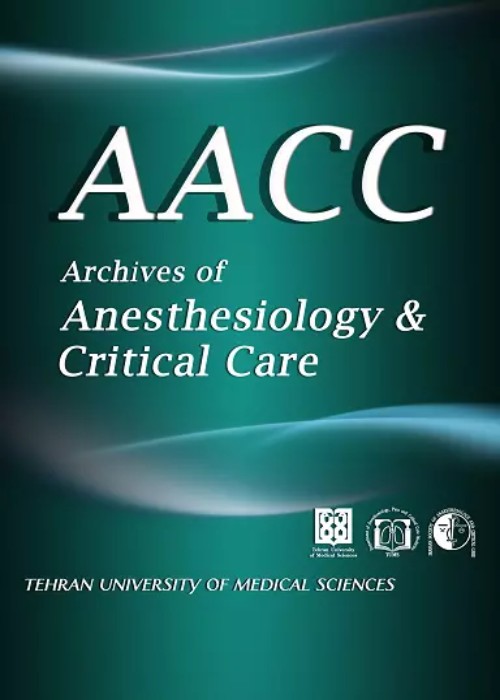Comparison of Ventilation Quality during Induction of General Anesthesia through Nasal and Face Mask Methods in patients with body mass index of greater than 25
Author(s):
Article Type:
Research/Original Article (دارای رتبه معتبر)
Abstract:
Background
Face mask ventilation has a distinct place in anesthesiology. One of the difficulties (obstacles, problems) with a mask, is laryngeal airway obstruction caused by the backward displacement of the tongue and soft tissue which is further exacerbated by obesity (body mass index over 25). Considering the fact that ventilation using a nasal mask appears to cause fewer problems especially in obese patients, we decided to compare the quality of ventilation after the induction of general anesthesia using ventilation through an anatomical face mask and anatomical nasal mask in patients with a body mass index (BMI) over 25 in this study.Methods
The study was a clinical trial, conducted on 70 patients between the ages of 18 and 70 years, with a BMI over 25, who were candidates for elective orthopedic surgery under general anesthesia at the Alzahra Hospital operating room. After evaluation of the inclusion criteria, the subjects were selected. Once placed on the operating table, the patients were administered 100% oxygen using a face mask held at proximity to the face for 3 minutes, after which anesthesia induction medication were administered to all patients. Subsequently, the patients were randomly divided into 2 groups. In the first group, ventilation was undertaken using the standard mask ventilation with 100 % oxygen for 3 minutes. In the second group, ventilation was performed through an anatomical nasal mask. The mean expiratory volume, mean SpO2, mean end tidal CO2 (Et CO2) and mean airway pressure were measured, recorded and compared in both groups.Results
From the ventilation parameters, maximum airway pressure during the 2nd minute after initiation of mask ventilation was significantly higher in the face mask group compared to the nasal mask group (4.6 1.6 and 12.5 1.7 respectively, pConclusion
According to the findings in this study, it can be concluded that ventilation with a nasal mask is more efficient than a face mask in patients with a BMI> 25 and is followed by a reduced amount of risk and complications.Keywords:
Language:
English
Published:
Archives of Anesthesiology and Critical Care, Volume:4 Issue: 3, Summer 2018
Pages:
488 to 491
magiran.com/p1855271
دانلود و مطالعه متن این مقاله با یکی از روشهای زیر امکان پذیر است:
اشتراک شخصی
با عضویت و پرداخت آنلاین حق اشتراک یکساله به مبلغ 1,390,000ريال میتوانید 70 عنوان مطلب دانلود کنید!
اشتراک سازمانی
به کتابخانه دانشگاه یا محل کار خود پیشنهاد کنید تا اشتراک سازمانی این پایگاه را برای دسترسی نامحدود همه کاربران به متن مطالب تهیه نمایند!
توجه!
- حق عضویت دریافتی صرف حمایت از نشریات عضو و نگهداری، تکمیل و توسعه مگیران میشود.
- پرداخت حق اشتراک و دانلود مقالات اجازه بازنشر آن در سایر رسانههای چاپی و دیجیتال را به کاربر نمیدهد.
دسترسی سراسری کاربران دانشگاه پیام نور!
اعضای هیئت علمی و دانشجویان دانشگاه پیام نور در سراسر کشور، در صورت ثبت نام با ایمیل دانشگاهی، تا پایان فروردین ماه 1403 به مقالات سایت دسترسی خواهند داشت!
In order to view content subscription is required
Personal subscription
Subscribe magiran.com for 70 € euros via PayPal and download 70 articles during a year.
Organization subscription
Please contact us to subscribe your university or library for unlimited access!


